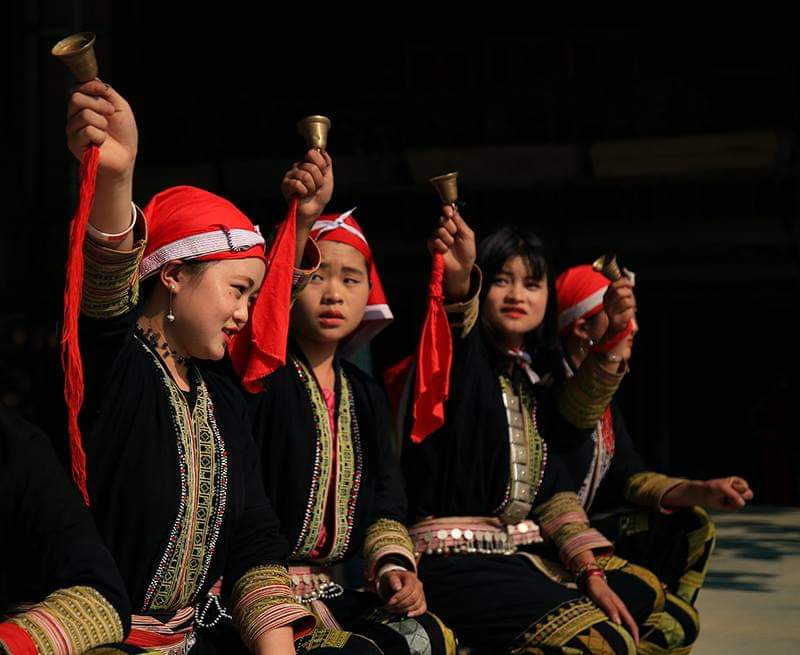"Blowing the soul" into traditional costumes
“Clack, clack, clack…”, The sound of sewing machine operated by the skillful feet and hands of Ms. Thao Thi My in Hoa Binh village, San Chai commune, Si Ma Cai district seemed to dispel the quiet atmosphere of the mountainous region.Ms. Thao Thi My, born in 1988, Mong ethnic, was born, raised and married in the land of San Chai. When My was 10 years old, her mother taught her to sew, embroider brocade, and make traditional costumes of the Mong people. In the past, Ms. My often took advantage of her leisure time to sew and embroider dresses and skirts for herself and her family members. Gradually, the love for traditional costumes made My more and more passionate about her work. Thanks to her creativity, the traditional costumes of the Mong people through the skillful hands of Ms. My seem to be breathed with new life, becoming more beautiful, both ensuring the tradition and following the fashion trend. Moreover, the traditional costumes made by Ms. My are highly appreciated for their aesthetics, so many people love to order them. Thanks to that, she also has big extra income by selling traditional costumes.
 |
| Ms. Thao Thi My sews the traditional dress of the Mong ethnic group for the customer order. |
Ms. My said: Previously, I accepted to sew the traditional costumes of Mong women, but now, I only specialize in brocade shirts. I like the traditional brocade shirt of the women of my ethnic group and want to create many beautiful shirts, suitable for each age and personality of each person through color coordination, combined with new embroidery patterns made by myself. Usually at the end of the year, near Tet holiday, there will be more orders, but on average, I make about 200 shirts a year.
Those who order Ms. Thao Thi My to sew brocade shirts are usually shop owners, clothing stalls, selling at fairs or tourist markets in Bac Ha, Si Ma Cai and many other places. With the average selling price of 800,000 dong to 1 million dong/shirt, making traditional costumes earns about 100 million dong per year for Ms. My. For the farmers in the highlands, this is a desirable income.
Ms. Sung Thi Chau, born in 1984, Mong ethnic, in Lao Chai village, San Chai commune is also one of the people who "blowing the soul" into the traditional costume of the Mong ethnic group in Si Ma Cai. Ms. Chau is also known as one of the first people to teach to make traditional dresses to many women in the village and commune. Through 17 years of working as the tailor, with skillful hands and delicate observation, the traditional costumes of Mong women that she makes have both traditional beauty and many creative and impressive impressions.
“The profession of making traditional national costumes is not the same as making other popular costumes (there are many sewing teachers and schools). Here, I almost have to come up with new models myself or refer on the Internet for beautiful and suitable dress and shirt models, then I can learn from them to sew for customers,” Ms. Sung Thi Chau said.
According to Ms. Chau, from the traditional costume of Mong women it can be innovated into many designs and models and it takes a lot of time to complete. Right from the stage of fabric selection, pattern design and model design, Ms. Chau has always put a lot of enthusiasm, so that each outfit will be suitable for each body shape and purpose of use (going out, wedding, festival...). Normally, an outfit in the form of long dress, elaborately sewn with many patterns, will take Ms. Chau at least 3 days to complete, including stitching beads, attaching decorative rings to the skirt. Simple shirts and short skirts will take 2 days. For thin and light clothes worn in daily life, Ms. Chau usually only takes 1 day to sew 3-5 sets.
Each costume, depending on the design and size, will cost from 500,000 dong to 3 million dong/set… On average, each year, the profession of sewing traditional costumes brings Chau's family income from 100 to 150 million dong (costs excluded). Realizing that this is the job that brings good income for the family, Ms. Chau has guided and shared experiences for many other women in the village, thereby forming the group to sew ethnic costumes for about 10 women to contribute to increase income, rise out of poverty and get rich in the homeland.
Ms. Sung Thi Cu, from Lao Chai village, San Chai commune, said: I knew about the profession of making traditional costumes nearly 6 years ago thanks to the guidance and encouragement of Ms. Sung Thi Chau. In addition to order tailoring, I also bring my own products to sell at markets such as: Sin Cheng, Can Cau, Lung Phinh, Xin Man (Ha Giang)... Since start of this profession, my family's life has changed, more stable income. I will stick with this profession for a long time and pass it on to my children.
Through the hands and minds of women who are passionate about traditional ethnic costumes in San Chai, the costumes are not simply dresses and shirts that meet common needs, but also beauty of national culture, each traditional costume seems to be "blown the soul" to become lively, beautiful, and impressive.
Ms. Vang Thi Di, Chairwoman of the Women's Organization of San Chai commune, Si Ma Cai district claimed: The profession of making traditional costumes has helped many female members in San Chai commune have good and stable income. Local authorities and the Women's Organization of the commune regularly encourage women to keep and maintain this traditional profession for economic development, to limit working away from home, so that they have more time to take care of their children and families. Currently, the locality has formed groups of women specializing in sewing women's dresses and shirts, and there are groups specializing in men's traditional costumes... both developing the household economy and preserving the traditional beauty and creating the unique features of San Chai.















